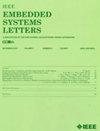基于流水线FFT架构的图像分类器的FPGA实现
IF 2
4区 计算机科学
Q3 COMPUTER SCIENCE, HARDWARE & ARCHITECTURE
引用次数: 0
摘要
深度神经网络(Deep neural network, DNN)是一类重要的机器学习算法,通常用于对图像和语音识别形式的数字数据进行分类。基于深度神经网络的图像分类器的计算复杂度高于传统的全连接前馈神经网络。因此,在机器视觉系统中,利用专用的云服务器和图形处理器单元(gpu)来实现高速、大容量的计算任务。然而,嵌入式系统对实时处理复杂机器学习任务的需求日益增长。由于FC层消耗的计算能力和内存占用率最高,因此为嵌入式系统创新新型节能和低占用的神经网络架构至关重要。本文利用VHDL在Stratix-10 FPGA上实现了一种基于流水线并行快速傅里叶变换(FFT)的FC-DNN架构。使用折叠FFT网络进一步减少了DNN的占用空间。使用MNIST手写数字数据库和CIFAR-10数据库两个基准训练集示例对该算法进行了测试。在这两种情况下,我们都达到了${\gt}~90$ %的准确率,而2并联折叠fft网络的功耗比传统的串联fft架构低45%左右。本文章由计算机程序翻译,如有差异,请以英文原文为准。
FPGA Implementation of an Image Classifier Using Pipelined FFT Architecture
Deep neural network (DNN) belongs to an important class of machine learning algorithms generally used to classify digital data in the form of image and speech recognition. The computational complexity of a DNN-based image classifier is higher than traditional fully connected (FC) feed-forward NNs. Therefore, dedicated cloud servers and graphical processor units (GPUs) are utilized to achieve high-speed and large-capacity computation tasks in machine vision systems. However, a growing demand exists for real-time processing of complex machine-learning tasks on embedded systems. As FC layers consume the highest fraction of computational power and memory footprint, innovating novel power-efficient and low-footprint NN architecture for embedded systems is crucial. In this letter, a pipelined and parallel fast Fourier transform (FFT)-based FC-DNN architecture is implemented on Stratix-10 FPGA using VHDL. The footprint of the DNN is further reduced using a folded FFT network. The proposed algorithm is tested using two benchmark training set examples, the MNIST database of handwritten digits and the CIFAR-10 database. In both cases, we achieve ${\gt }~90$ % accuracy, while the power consumption of the 2-parallel folded FFT-based network is around 45% less than the traditional series FFT-based architectures.
求助全文
通过发布文献求助,成功后即可免费获取论文全文。
去求助
来源期刊

IEEE Embedded Systems Letters
Engineering-Control and Systems Engineering
CiteScore
3.30
自引率
0.00%
发文量
65
期刊介绍:
The IEEE Embedded Systems Letters (ESL), provides a forum for rapid dissemination of latest technical advances in embedded systems and related areas in embedded software. The emphasis is on models, methods, and tools that ensure secure, correct, efficient and robust design of embedded systems and their applications.
 求助内容:
求助内容: 应助结果提醒方式:
应助结果提醒方式:


